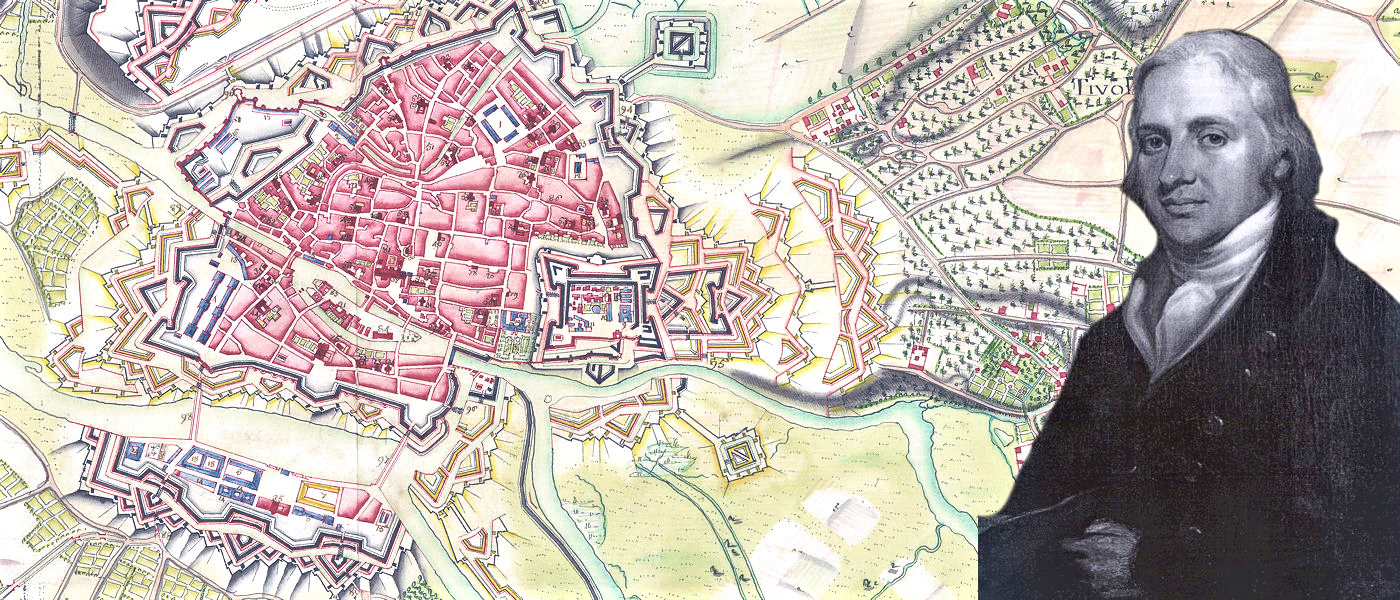The Clifford Connections
Robert Clifford returned home to England from the continent after his military service with Dillon’s Regiment during the winter of 1793-1794. Because England was now at war with France, his first-hand knowledge of the country, its military, language, geography, and people, was highly prised and he quickly became an indispensable advisor to top British military leaders. His most ardent supporter amongst the military would be General John Graves Simcoe, who was put in charge of the defence of the Western District (Devon and part of Somerset) upon his return from Upper Canada. The Simcoes and Cliffords were relative neighbours, both living in Devon barely 15 miles apart on either side of Exeter—the Simcoes just northeast at Wolford Lodge, and the Cliffords just southwest at Ugbrooke House near Chudleigh. Clifford and Simcoe would become life-long friends and would often exchange books and maps (see the maps of Alexandria given to Clifford by Simcoe). Both men also rented townhouses in London on Welbeck Street. Simcoe would call upon Clifford’s expertise to aid him in his defence plans for the entire southern portion of England against a possible invasion by Napoleon. This included Clifford's production of a series of skeleton maps that could be annotated by officers in the field. Existing mapping of the area--and all of England for that matter--was totally inadequate. The best scale available was a set of maps at 5 miles to the inch, produced by a private London map publisher, John Cary, and were the maps recommended to Napoleon by Charles Picquet, the official supplier of maps to the French army, for his invasion plans. Clifford would use these as the base for his skeleton maps.
The English, therefore, lagged far behind the French in the field of cartography. The French had spent over 100 years compiling and completing the first trigonometric survey of a country—the Carte de France (comprised of 180 sheets measuring 36 feet by 39 feet when fully assembled). The Austrian Empire had copied French techniques and had completed the “Ferraris” map of the Austrian Netherlands (modern-day Belgium) which would be used in various formats by all the belligerent armies during the Battle of Waterloo. Clifford had copies of both of these map sets in his private collection.
The British Ordnance Survey, on the other hand, was still collecting data in the field through trigonometrical survey and had not yet embarked on draughting accurate topographical maps except for a few sheets. William Mudge was placed in charge of this effort. He set up a temporary headquarters in Chudleigh (1803), when working on the sheets covering Devon, to be in close proximity to Ugbrooke House in order to take advantage of Robert Clifford’s technical expertise and advice. The Devon sheet was published in 1809 but restricted from public sale for reason of military secrecy. Despite this, in 1813 John Cary, the private London map seller, made publicly available his reduced version of the 1809 Ordnance Survey map. He argued that since the public paid for the Ordnance Survey, it had a right to publish copies of the OS maps on scales suited to their own needs. Production of the map may have been stopped by the government, as the late Professor William Ravenhill of the University of Exeter believed the only existing copy of this map to be held in the West Country Studies Library in Devon. It is recorded, however, that Cary sent Robert Clifford a copy for his evaluation and comments. Clifford's copy in McMaster's collection may therefore be the only other one to have survived. Clifford would also act as a consultant for Cary when he was creating his map of the 1812 Russian Campaign. A rough sketch related to this project exists in the McMaster Clifford Collection.
Sources:
More in-depth information on the Clifford-Simcoe-Mudge-Cary connections can be found by reading the articles by Professor William Ravenhill and the book by Mary Beacock Fryer and Christopher Dracott listed under the “References” tab on the Robert Clifford website landing page.
View a list of original letters written between Robert Clifford and John Graves Simcoe and held at the Archives of Ontario.

